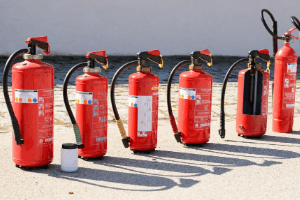Fires are a danger that we can meet on our paths every day. They are usually caused by human carelessness when using open fire or flammable substances, but also by arson, installation failures or natural forces. During a fire, quick and thoughtful reaction is essential. Our safety is paramount, but it is also important to know different methods and means of extinguishing fires. So, let's see the measures that have been developed to effectively extinguish fires.

Fire fighting
When extinguishing a fire, it is very important to be effective and fast, and to reduce the risk of fire recurrence. It is important which extinguishing agents we use to achieve this effect. The right choice depends, on such factors as among others: the scale of the fire, the type of burning materials or what we want to protect from burning.
Water is the easiest extinguishing agent available, but it can only be used for extinguishing solids. That is why a whole range of specialist preparations and agents belonging to firefighting chemistry was created, and they are used to extinguish various types of fires. A fire triggered at home or in the forest will be very different from a fire at a chemical plant. It is therefore very important to choose the right extinguishing agents for a hazard specific emergency situation.
Foam-forming surfactants
Extinguishing agents are composed of a number of components that determine its physicochemical and functional properties. The key parameter is to achieve stable and high foam, which is provided by the right foaming agents. In such case surfactants with foaming properties are used.
Manufacturers such as the PCC Group offer a wide range of foaming agents, which are excellent for the production of fillings for various types of foam extinguishers and for synthetic extinguishing agents. In the product catalogue of the PCC Group we can find, among others, anionic surfactants in the form of sulphate salts of fatty alcohols – ROSULfans, as well as their ethoxylated derivatives – SULFOROKAnoles. Among the products there are also amphoteric surfactants in the form of betaine with different content of active substance – ROKAmin. The offered products are distinguished by their exceptional foaming properties, stabilizing and supporting action in the process of foam formation.
Synthetic extinguishing media
They are used to produce mechanical extinguishing foam: heavy, medium and light, using all available mechanical devices.
The extinguishing foam cuts off the access of oxygen, which allows to extinguish the fire effectively and quickly of both solids and liquids while preventing its spread and recurrence.
In the portfolio of PCC Group, you can find synthetic extinguishing agents such as Roteor M Premium, already known on the market, and the new product Roteor M Plus, which shows better extinguishing efficiency. Both products are used to extinguish fires of classes A (solids) and B (liquids not mixed with water) using tap water and sea water. The use of highly specialised surfactants makes our products suitable as well as wetting agents in the concentration range from 0.5 to 1%.
Our products have been tested in reputable units such as CNBOP-PIB or MPA Dresden, thus obtaining certificates for compliance with the European standard EN 1568-1,2,3:2018.
Roteor series products are recommended for fire brigades, forest services, chemical plants, factories, airports, fuel bases and refineries.
Aqueous fire-fighting agents
Some places and objects are very sensitive to water, so other agents are required to extinguish such fires. For such fires, products such as special gases of various kinds and extinguishing powders are used. They cut off the oxygen supply, similar to the effect in case of foam. However, compared to classical fire-fighting methods, they have several disadvantages, e.g. difficulty in use in adverse weather conditions – strong wind.
We should always remember that safety is paramount. Therefore, the selection of appropriate and proven extinguishing and fire protection agents is very important. It is worth choosing products that have been tested by authorized institutions and have appropriate approvals. The certificates prove their safety as well as their effectiveness. Let’s choose the agents that are appropriate to the situation. This will allow us to properly protect our health and life.
- https://www.gov.pl/web/kppsp-rypin/zasady-uzycia-podrecznego-sprzetu-gasniczego
- https://www.przeciwpozarowy.com/typy-oznakowanie-rodzaje-gasnic
- https://bezpieczenstwo-bhp.pl/blog/blog-o-bezpieczenstwie-bhp/rodzaje-gasnic-i-ich-oznakowanie
- https://www.elektroinzynieria.pl/wiadomosci-i-komunikaty/co-ugasisz-gasnica-pianowa-najwazniejsze-informacje-220007-10